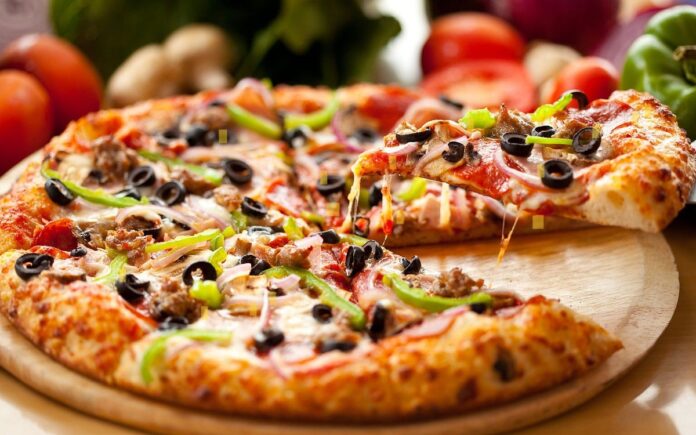Life Style
The Pizza Edition: Unleashing Deliciousness Slice by Slice
Published
6 months agoon
By
James flick
Introduction
Who doesn’t love pizza? From its humble beginnings in Italy to becoming a global sensation, pizza has conquered hearts (and stomachs) worldwide. Whether you’re a fan of classic margherita, loaded pepperoni, or adventurous gourmet slices, there’s a pizza for everyone. Today, we’ll dive into the delectable world of pizza, exploring its history, types, ingredients, and much more. Ready to unleash some deliciousness? Let’s get started!
The History of Pizza
Pizza’s story begins in Italy, specifically Naples, where the simple yet flavorful combination of dough, tomatoes, and cheese created a culinary phenomenon. The term “pizza” first appeared in a Latin text from 997 AD, but it wasn’t until the late 18th century that the modern pizza as we know it began to take shape.
As Italian immigrants moved to other countries, they brought their beloved pizza with them. In the early 20th century, pizza made its way to the United States, where it underwent various transformations, leading to the creation of new styles like New York’s thin crust and Chicago’s deep dish. Today, pizza is a global staple, enjoyed in countless variations worldwide.
Types of Pizza

Pizza comes in many delightful forms. Let’s explore some of the most popular types:
Neapolitan Pizza
Originating from Naples, this pizza features a thin, soft crust with a puffy edge, topped with simple ingredients like tomatoes, mozzarella, and basil. It’s traditionally cooked in a wood-fired oven at high temperatures.
Chicago Deep Dish
This American classic is known for its thick, pie-like crust, loaded with layers of cheese, meat, and chunky tomato sauce. It’s baked in a deep pan, resulting in a rich, hearty meal.
New York Style
Characterized by its large, thin, and foldable slices, New York-style pizza is all about convenience without sacrificing flavor. It’s often topped with a generous layer of mozzarella and a simple tomato sauce.
Sicilian Pizza
Sicilian pizza features a thick, rectangular crust, often topped with robust tomato sauce, onions, anchovies, and herbs. It’s a hearty, filling option that’s deeply rooted in Italian tradition.
Other Regional Varieties
From Detroit’s square deep-dish to California’s innovative toppings, pizza’s versatility knows no bounds. Each region adds its own unique twist, contributing to the rich tapestry of pizza culture.
Key Ingredients for the Perfect Pizza
Creating the perfect pizza starts with selecting high-quality ingredients. Here’s what you need:
Dough
The foundation of any great pizza is its dough. Made from flour, water, yeast, and salt, achieving the right texture and flavor is crucial. The best doughs are well-kneaded, allowed to rise properly, and have a good balance of elasticity and chewiness.
Sauce
A good sauce can elevate your pizza from ordinary to extraordinary. While traditional tomato sauce remains a favorite, other options like pesto, white garlic sauce, and barbecue sauce offer exciting alternatives.
Cheese
Mozzarella is the classic choice, known for its meltability and mild flavor. However, exploring other cheeses like provolone, gouda, and even vegan options can add unique dimensions to your pizza.
Toppings
From pepperoni and sausage to mushrooms and arugula, the sky’s the limit when it comes to toppings. Balancing flavors and textures is key to creating a harmonious pizza.
Making the Perfect Dough
Essential Ingredients
To make the perfect pizza dough, you’ll need:
- Flour (preferably bread flour for its high gluten content)
- Water
- Yeast
- Salt
- Olive oil (optional for added flavor)
Step-by-Step Preparation
- Mixing: Combine flour, water, yeast, and salt in a large bowl. Mix until a rough dough forms.
- Kneading: Turn the dough onto a floured surface and knead for about 10 minutes until smooth and elastic.
- Rising: Place the dough in a lightly oiled bowl, cover with a damp cloth, and let it rise in a warm place for 1-2 hours until doubled in size.
- Shaping: Punch down the risen dough and shape it into your desired pizza base.
Tips for the Perfect Rise
- Use warm water (about 110°F) to activate the yeast.
- Let the dough rise in a draft-free environment.
- For a more flavorful dough, let it rise slowly in the refrigerator overnight.
Choosing the Right Sauce
Traditional Tomato Sauce
A simple blend of tomatoes, garlic, olive oil, and basil can make a world of difference. Simmering the sauce for a few hours enhances the flavors, creating a rich, robust base for your pizza.
Alternative Sauces
For a twist, try sauces like:
- Pesto: A vibrant mix of basil, garlic, pine nuts, Parmesan, and olive oil.
- White Garlic Sauce: Creamy and garlicky, perfect for chicken or seafood pizzas.
- Barbecue Sauce: Adds a sweet and smoky flavor, ideal for meat lovers.
Balancing Flavors
Ensure your sauce complements the toppings. A tangy tomato sauce pairs well with rich cheeses and meats, while a lighter sauce like pesto works beautifully with vegetables and seafood.
Cheese Choices
Classic Mozzarella
Mozzarella is prized for its meltability and mild flavor, making it the go-to cheese for many pizza lovers.
Blends and Specialty Cheeses
Combining cheeses like provolone, Parmesan, and gouda can create complex flavor profiles. Experimenting with blue cheese or goat cheese can also add a gourmet touch.
Vegan Cheese Options
For those avoiding dairy, vegan cheeses made from nuts, soy, or tapioca offer excellent meltability and flavor.
Toppings: The Crown Jewels
Popular Meat Toppings
Pepperoni, sausage, and ham are staples in the meat topping category. Their savory, spiced flavors add a satisfying richness to any pizza.
Vegetarian and Vegan Options
Veggies like bell peppers, onions, mushrooms, and olives bring color and flavor. Vegan options like tofu, tempeh, and plant-based meats are also delicious alternatives.
Gourmet and Exotic Toppings
For a touch of luxury, try toppings like truffle oil, arugula, prosciutto, or even figs and honey.
Cooking Techniques
Oven Baking
The most common method, oven baking, requires preheating your oven to its highest setting (usually 500°F or higher) and using a pizza stone or steel for optimal crust texture.
Grilling
Grilling pizza adds a smoky flavor and unique texture. Use indirect heat and rotate the pizza frequently to avoid burning.
Wood-fired ovens
Wood-fired ovens impart a distinct smokiness and char to pizzas, mimicking the traditional Neapolitan-style cooking. These ovens reach high temperatures quickly, resulting in fast cooking times and crispy crusts.
Pizza Making at Home
Necessary Equipment
To make pizza at home, you’ll need:
- Pizza stone or steel
- Pizza peel
- Rolling pin or dough docker
- Oven or grill
- Pizza cutter
Step-by-Step Guide
- Prepare the Dough: Follow the recipe for your preferred pizza dough, ensuring proper kneading and rising.
- Preheat the Oven: Place your pizza stone or steel in the oven and preheat it to the highest temperature.
- Shape the Dough: Roll out the dough on a floured surface to your desired thickness.
- Add Sauce and Toppings: Spread sauce evenly over the dough, leaving a border for the crust. Add cheese and toppings of your choice.
- Transfer to Oven: Using a pizza peel, carefully slide the pizza onto the preheated stone or steel.
- Bake: Cook the pizza for 8-10 minutes or until the crust is golden brown and the cheese is bubbly.
- Slice and Serve: Use a pizza cutter to slice the pizza into wedges or squares and enjoy!
Common Pitfalls and How to Avoid Them
- Soggy Crust: Avoid overloading the pizza with toppings, as excess moisture can make the crust soggy. Pre-bake the crust for a few minutes before adding toppings to ensure a crisp base.
- Burnt Cheese: If your cheese is browning too quickly, try reducing the oven temperature or placing the pizza on a lower rack.
- Sticky Dough: If your dough is too sticky to work with, add a little flour as needed while rolling it out.
Healthy Pizza Options
While pizza is often considered a guilty pleasure, it can also be part of a balanced diet. Here are some tips for healthier pizza:
- Whole Grain and Gluten-Free Crusts: Opt for whole grain or gluten-free crusts for added fiber and nutrients.
- Low-Fat Cheese and Healthy Toppings: Use part-skim mozzarella or try lighter cheese options like feta or goat cheese. Load up on veggies for added vitamins and minerals.
- Portion Control: Enjoy pizza in moderation and pair it with a side salad or fresh fruit for a well-rounded meal.
Pairing Pizza with Drinks
Finding the perfect beverage to accompany your pizza can enhance the dining experience. Here are some classic pairings:
- Soda: The carbonation and sweetness of soda cut through the richness of pizza, making it a classic choice.
- Beer: Whether it’s a crisp lager, hoppy IPA, or malty stout, beer’s effervescence and complexity complement the flavors of pizza.
- Wine: Pairing wine with pizza is all about balance. Opt for a light, acidic wine like Pinot Noir or Sangiovese for tomato-based pizzas, or a dry white wine like Sauvignon Blanc for seafood or veggie pizzas.
- Non-Alcoholic Options: If you prefer non-alcoholic beverages, try sparkling water with a splash of citrus or a fruity herbal tea.
Cultural Impact of Pizza
Pizza isn’t just a food—it’s a cultural phenomenon. From its portrayal in movies and TV shows to its role in social gatherings, pizza holds a special place in our hearts. Pizza parties, pizza nights, and even pizza-themed weddings are testament to its widespread appeal.
Innovative Pizza Trends
As tastes evolve and culinary boundaries are pushed, pizza continues to reinvent itself. From fusion pizzas that blend flavors from different cuisines to dessert pizzas that satisfy your sweet tooth, there’s always something new to discover in the world of pizza.
Conclusion
In conclusion, pizza is more than just a food—it’s a culinary adventure waiting to be explored. Whether you’re a traditionalist who loves a classic margherita or an adventurous eater eager to try the latest gourmet toppings, there’s a pizza out there for you. So roll up your sleeves, gather your ingredients, and unleash deliciousness slice by slice!
FAQs
- What is the best flour for pizza dough?
- High-protein bread flour is ideal for pizza dough, as it creates a chewy crust with good structure.
- Can pizza be healthy?
- Yes, pizza can be part of a healthy diet when made with whole grain crust, lean proteins, and plenty of veggies.
- How do I make a gluten-free pizza?
- Use a gluten-free flour blend or alternative flours like almond or coconut flour to make a gluten-free crust. Be sure to check all toppings for gluten-containing ingredients.
- What are some unusual pizza toppings worth trying?
- Experiment with toppings like figs, prosciutto, truffle oil, or even pineapple for a unique twist on classic pizza.
- How do I store leftover pizza?
- Wrap leftover pizza slices in foil or store them in an airtight container in the refrigerator for up to 3-4 days. Reheat in a preheated oven or toaster oven for best results.
